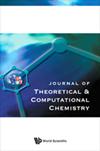计算科学虚拟会议论文集(VCCS-2019)前言
IF 2.4
Q3 Computer Science
Journal of Theoretical & Computational Chemistry
Pub Date : 2021-06-07
DOI:10.1515/9783110682045-202
引用次数: 0
摘要
2019年8月1日至31日在线组织了一场计算科学虚拟会议(VCCS-2019)。这是自2013年开始的第七次虚拟会议。选择8月是为了纪念8月12日量子力学之父欧文Schrödinger的诞辰。这次虚拟会议有来自25个国家的110名与会者进行了40场演讲。一个安全的平台被用于参与者的虚拟互动。在虚拟会议之后,有人呼吁考虑在会议论文集中发表全文。手稿收到后,按照德格吕特的政策进行处理和审查。这本书是基于使用计算化学方法的13个接受的手稿的集合。这些手稿涵盖了从基础科学到应用科学的一系列主题。Parlak等人利用DFT和TDDFT模拟研究了3-卤代苯甲醛的结构和光谱性质。Francis和Govender通过二维范德华异质结构工程研究了单层GaTe2光伏电池。Sekar等人利用DFT、TDDFT和非线性光学方法探索了具有刚性(吡唑)供体和刚性(苯并噻吩二氧化物)受体的荧光苯乙烯基发色团。Sekar和Shinde通过DFT计算对萘基荧光酸性偶氮染料的ESIPT和偶氮腙互变异构进行了比较研究。Olasegun等人研究了花青素在染料敏化太阳能电池中作为敏化剂的效率。Oluwasegun等通过计算对接研究,分析了具有抗肿瘤活性的oxypeucedanin对人前列腺癌DU145细胞的抑制潜力。Ambrose等人通过三维量构效关系和分子对接相结合,对噻唑烷酮衍生物与PTP-1B相互作用的机理进行了深入研究。库兹涅佐夫回顾了基于石墨烯量子点的纳米复合材料的研究。Oloba-Whenu等人用DFT法研究了3,5-二硝基甲氧基吡啶和3,5-二硝基甲氧基吡啶与哌啶的反应。Alabi等合成并表征了1,3-二[(E)-呋喃-2-基)亚甲基]尿素和1,3-二[(E)-呋喃-2-基)亚甲基]硫脲,并用DFT方法对实验研究进行了补充。Bilonda和Mammino报道了植物源生物活性生物碱的计算研究。Yusuf等人利用DFT方法研究了一些席夫碱的生物作用。n铁康回顾了分子力学方法在合理药物设计中的作用,特别强调了力场和溶剂化模型的作用。我希望这些章节将增加文献,他们将是研究人员有用的参考。本文章由计算机程序翻译,如有差异,请以英文原文为准。
Preface of the Book of Proceedings of the Virtual Conference on Computational Science (VCCS-2019)
A virtual conference on computational science (VCCS-2019) was organized online from 1 to 31 August 2019. This was the seventh virtual conference which was started in 2013. The month of August was chosen to commemorate the birth anniversary of Erwin Schrödinger, the father of quantum mechanics, on 12 August. There were 40 presentations for the virtual conference with 110 participants from 25 countries. A secured platform was used for virtual interactions of the participants. After the virtual conference, there was a call for full papers to be considered for publication in the conference proceedings. Manuscripts were received and they were processed and reviewed as per the policy of De Gruyter. This book is a collection of the thirteen accepted manuscripts based on the use of computational chemistry methods. These manuscripts cover a range of topics from fundamental to applied science. Parlak et al investigated the structural and spectroscopic properties of 3-halogenobenzaldehydes using DFT and TDDFT simulations. Francis and Govender studied photovoltaic cells of monolayer GaTe2 via two-dimensional van der Waals heterostructures engineering. Sekar et al explored fluorescent styryl chromophores with rigid (pyrazole) donor and rigid (benzothiophenedioxide) acceptor using DFT, TDDFT and nonlinear optical methods. Sekar and Shinde did comparative studies of the ESIPT and azo-hydrazone tautomerism in naphthalene based fluorescent acid azo dyes by DFT computations. Olasegun et al examined the efficiency of anthocyanidins as sensitizers in dye-sensitized solar cells. Oluwasegun et al analysed the inhibitory potential of the oxypeucedanin, which has anti-tumour activity against human prostate carcinoma DU145 cells, by computation docking studies. Ambrose et al provides a mechanistic insight into interactions between thiazolidinedones derivatives and PTP-1B through combination of three dimensional quantity structural-activity relationship and molecular docking. Kuznetsov reviewed research of nanocomposites based on graphene quantum dots. Oloba-Whenu et al studied the reaction of 3,5-dinitroethoxypyridine and 3,5-dinitromethoxypyridine with piperidine using DFT method. Alabi et al synthesised, characterized and 1,3-bis [(E)-furan-2-yl) methylene] urea and 1,3-bis [(E)-furan-2-yl) methylene] thiourea and they complemented the experimental research using DFT method. Bilonda and Mammino reports on the computational studies of biologically active alkaloids of plant origin. Yusuf et al investigated the biological actions of some Schiff bases using DFT method. Ntie-Kang reviewed molecular mechanics approaches for rational drug design with a special emphasis on the role of force fields and solvation models. I hope that these chapters will add to literature and they will be useful references for researchers.
求助全文
通过发布文献求助,成功后即可免费获取论文全文。
去求助
来源期刊
CiteScore
1.70
自引率
0.00%
发文量
0
审稿时长
3 months
期刊介绍:
The Journal of Theoretical and Computational Chemistry (JTCC) is an international interdisciplinary journal aimed at providing comprehensive coverage on the latest developments and applications of research in the ever-expanding field of theoretical and computational chemistry.
JTCC publishes regular articles and reviews on new methodology, software, web server and database developments. The applications of existing theoretical and computational methods which produce significant new insights into important problems are also welcomed. Papers reporting joint computational and experimental investigations are encouraged. The journal will not consider manuscripts reporting straightforward calculations of the properties of molecules with existing software packages without addressing a significant scientific problem.
Areas covered by the journal include molecular dynamics, computer-aided molecular design, modeling effects of mutation on stability and dynamics of macromolecules, quantum mechanics, statistical mechanics and other related topics.

 求助内容:
求助内容: 应助结果提醒方式:
应助结果提醒方式:


